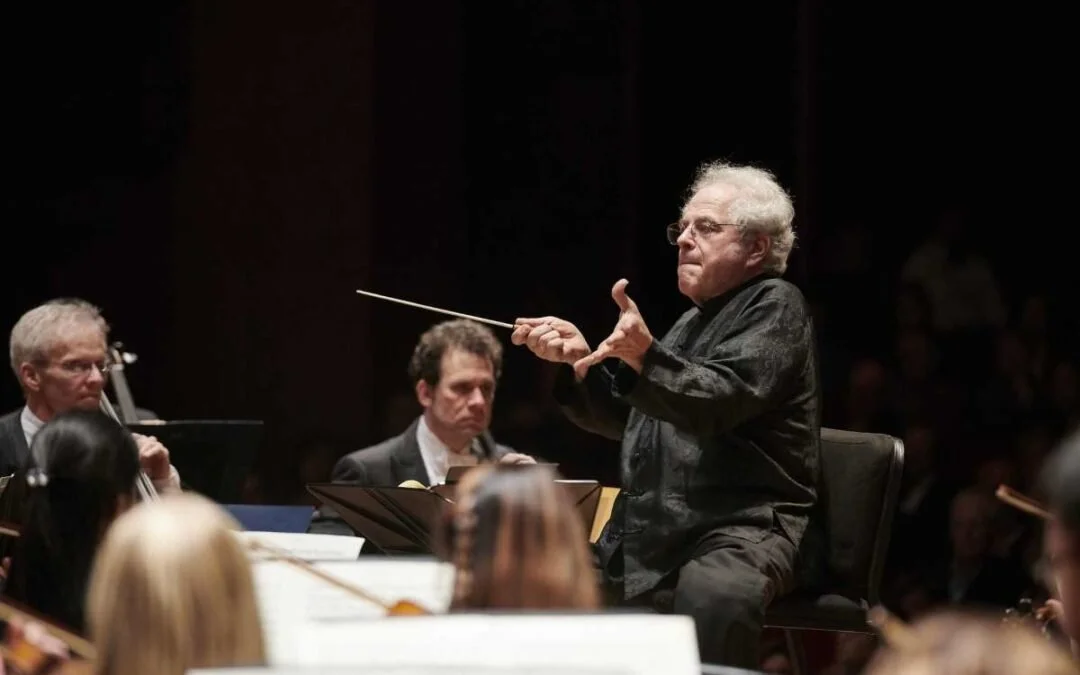Top praise for Itzhak Perlman conducting Houston Symphony
Itzhak Perlman conducts the Houston Symphony (Photo credit: Anthony Rathbun)
Review: Itzhak Perlman stars with Houston Symphony on violin and podium
By Chris Gray
Houston Symphony
October 19, 2018
As a violinist, Itzhak Perlman is a rock star of the classical world.
As a conductor, he’s about as expressive as a man can be with his back turned.
Onstage with the Houston Symphony Thursday night, Perlman showed he can be as skilled and sympathetic a leader as he is a virtuoso performer.
Stricken with polio as a toddler, Perlman turned to music to prove whatever limitations imposed on him by his body have no pull whatsoever on his spirit. Following Thursday’s opener, this weekend the 73-year-old multiple Grammy winner (16 times over) and Kennedy Center honoree will be back at on the podium for two more “Perlman Plays & Conducts” concerts, leading an evening of Bach, Mozart and Schumann.
All three selections are rich with varying moods and textures, allowing Perlman plenty of latitude to draw out a distinctive interpretation with simply a flick of his wrist or cupping of his free hand.
The evening’s second half, Schumann’s Symphony No. 4 in D minor, is a stalwart work of the Romantic era. Coaxing the orchestra past a tentative and moody introduction, Perlman lost no time digging into the opening movement’s fast-flowing main theme, a spirited passage that spoke of derring-do and high adventure — now and again the score feinted toward more tender territory, but Perlman’s furiously waving hands never let the ensemble tarry for too long.
The time for more amatory thoughts instead came in the sweet-sounding second movement, or “Romanza,” where lovely solo cello and violin passages eventually branched off from the main melody, a lonely bassoon also plying the audience’s heartstrings. The opener’s intrepid brio returned in the playful and passionate scherzo/trio movement, and a jaunty extended finale in which, even as his baton briskly ticked away the measures, Perlman’s left hand carried on its own complex conversation of accents and cues.
Before intermission, Perlman led the orchestra through Mozart’s Symphony No. 40 in G minor, completed three years before the composer’s 1791 death at just 35. The first movement’s primary theme remains one of Mozart’s most recognizable melodies, mysterious and inscrutable but irretrievably sad. Structurally, the opener stands as one of his great puzzle boxes, soon introducing a more hesitant secondary theme that weaves in and out of its counterpart, touching off a dynamic orchestra-wide back-and-forth where the low strings act as ballast to the skyward-arcing violins.
Perlman’s intuitive conducting style especially brought out the warmth of the pastoral-sounding second movement — the chirping flutes doubling for birds, perhaps — nudging and restraining the orchestra through the wistful main melody, which turned ominous and foreboding late before striking a more reassuring tone at the very end.
The concluding two movements were, not to put too fine a point on it, pure symphonic fun — an exciting and majestic minuetto and trio marked by almost Bach-like precision; and a pitched finale that resumed the opening movement’s spirited conversation, the strings sawing away in full flight as clarinet and French horn provided a few splashy accents.
When things got especially thrilling, Perlman lifted his free hand in the air almost like a gesture of triumph.
After the epic ensembles assembled for Mahler’s “Resurrection” symphony and Dvorak’s “Stabat Mater” in recent weeks, it was somewhat startling to see that the personnel featured in the evening’s opener, Bach’s Violin Concerto No. 1 in A minor, could have just as easily fit in the foyer of Jones Hall as onstage.
Composed during the same fruitful period that yielded the famous Brandenburg concertos and solo cello suites, the concerto bears all the hallmarks of classic Bach: cascading notes that pit assorted instruments in dialogue with one another; a near-mathematical harmonic structure; a feeling of constant motion and implicit grace.
For his sole number as performer and conductor, Perlman used his bow and some rather emphatic nods of his head rather than a baton to conduct the diminished ensemble (which here included a harpsichord). Methodically but expressively enticing the notes out of his violin, he gave off the impression of someone so intimately acquainted with his instrument that he plays as much by feel as by sound.
Truth be told, this concerto — in which the soloist and orchestra repeatedly pass a ritornello, or refrain, back and forth throughout each of three movements — seemed relatively modest given Perlman’s abundant technical gifts, but the vibrancy this remarkable musician brings to his craft nevertheless came through loud and clear.
For the full article, click here!


